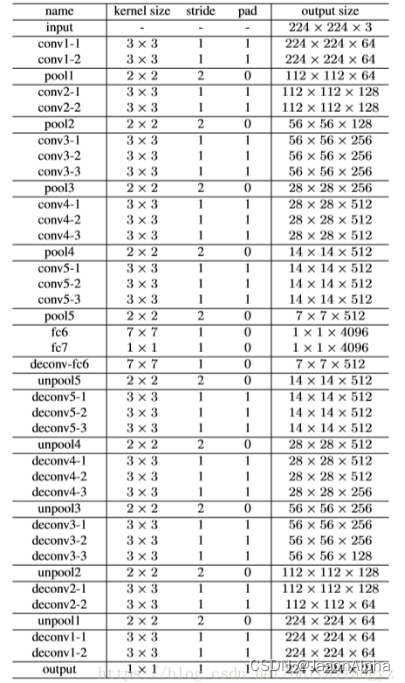《2015_Noh_Cite=4488_Learning deconvolution network for semantic segmentation》
铺垫和引入
encoder使用VGG-16的卷积层进行学习,decoder使用反卷积deconv和反池化unpool进行上采样。
将object proposal候选域推荐(edge box画方框)送入训练后的网络,整幅图像是这些proposal分割结果的组合,这样就可以解决物体太大或者太小所带来的分割问题,改进了现存基于FCN的方法
? ? ? ? 但是这样做需要人为干预,网络从全自动变成半自动的,我们其实不推荐这样改。
FCN的critical limitations
- 感受野大小固定predefined fixed-size?receptive field。——The object that is substantially larger or smaller than the receptive field may be fragmented支离破碎的-割开?or mislabeled
- (1)有的太大的物体,我的感受野如果没那么大的话,会导致分割错误,因为我们没有把整个大物体都看全,我就会认为整个大物体是由两个小物体组成的(意思就是你把 一个东西给割成了两个物体),从而造成错分。大的object只会用到局部信息Label prediction is done with only local information for large objects and相同标签的object可能会被赋上不同的标签?the pixels that belong to the same object may have inconsistent不同的-不一致的 label。你可以看原文提供的下图,你的感受野比较小,object很大,图中好几个小物体识别不出来,train bycycle persion各自的像素点都被label成了bus

- (2)尺度太小的物体,由于我的感受 野是 比较大的,看到的物体的背景信息和其他信息比较多,进而影响我对这个小物体的判断,我很容易把这些小物体当做background。Small objects are often ignored and classified as background.图中这些人太小了,FCN误把他们当做background上的几个纹理了,没识别出来。

- (1)有的太大的物体,我的感受野如果没那么大的话,会导致分割错误,因为我们没有把整个大物体都看全,我就会认为整个大物体是由两个小物体组成的(意思就是你把 一个东西给割成了两个物体),从而造成错分。大的object只会用到局部信息Label prediction is done with only local information for large objects and相同标签的object可能会被赋上不同的标签?the pixels that belong to the same object may have inconsistent不同的-不一致的 label。你可以看原文提供的下图,你的感受野比较小,object很大,图中好几个小物体识别不出来,train bycycle persion各自的像素点都被label成了bus
- ?这个特征图经过很多次下采样以后就变得很模糊了、像素很低了、尺寸太小了,在这个过程中物体的精细结构和细节经常被丢失,然后你再把这个很模糊的特征图送给反卷积层进上采样恢复,很难做到精细分割这个效果
模型结构DeconvNet

? Encoder和Decoder部分是在模仿VGG-16
? ? ? ? Encoder(它起名叫Convolution network):卷积-卷积-池化”两次,“卷积-卷积-卷积-池化”三次
? ? ? ? 中间是两个全连接层,其实我个人觉得没必要,一是大大增大的参数量,二是一个二维的图变成一维向量没啥意义,对performance的提高其实很有限
? ? ? ? Decoder(它起名叫Deconvolution network):“上采样-卷积-卷积-卷积”三次,“上采样-卷积-卷积”两次
? ? ? ? 一个softmax分类层
池化的作用:
? ? ? ? 过滤上一层的噪音,如何做到过滤呢?用感受野内一个单独的代表值作为激活来提取想要的信息Pooling in convolution network is designed to filter noisy actications in a lower layer by abstracting提取、摘要、抽象化?activations in a receptive field with a single representative value
? ? ? ? 但是池化也丢失了一部分的空间信息。spatial information within a receptive filed is lost during pooling
代码实现
各层网络的参数和尺寸表

import torch
import torchvision.models as models
from torch import nn
vgg16_pretrained = models.vgg16(pretrained=False)
def decoder(input_channel, output_channel, num=3):
if num == 3:
decoder_body = nn.Sequential(
nn.ConvTranspose2d(input_channel, input_channel, 3, padding=1),
nn.ConvTranspose2d(input_channel, input_channel, 3, padding=1),
nn.ConvTranspose2d(input_channel, output_channel, 3, padding=1))
elif num == 2:
decoder_body = nn.Sequential(
nn.ConvTranspose2d(input_channel, input_channel, 3, padding=1),
nn.ConvTranspose2d(input_channel, output_channel, 3, padding=1))
return decoder_body
class VGG16_deconv(torch.nn.Module):
def __init__(self):
super(VGG16_deconv, self).__init__()
pool_list = [4, 9, 16, 23, 30]
for index in pool_list:
vgg16_pretrained.features[index].return_indices = True
self.encoder1 = vgg16_pretrained.features[:4]
self.pool1 = vgg16_pretrained.features[4]
self.encoder2 = vgg16_pretrained.features[5:9]
self.pool2 = vgg16_pretrained.features[9]
self.encoder3 = vgg16_pretrained.features[10:16]
self.pool3 = vgg16_pretrained.features[16]
self.encoder4 = vgg16_pretrained.features[17:23]
self.pool4 = vgg16_pretrained.features[23]
self.encoder5 = vgg16_pretrained.features[24:30]
self.pool5 = vgg16_pretrained.features[30]
self.classifier = nn.Sequential(
torch.nn.Linear(512 * 11 * 15, 4096),
torch.nn.ReLU(),
torch.nn.Linear(4096, 512 * 11 * 15),
torch.nn.ReLU(),
)
self.decoder5 = decoder(512, 512)
self.unpool5 = nn.MaxUnpool2d(2, 2)
self.decoder4 = decoder(512, 256)
self.unpool4 = nn.MaxUnpool2d(2, 2)
self.decoder3 = decoder(256, 128)
self.unpool3 = nn.MaxUnpool2d(2, 2)
self.decoder2 = decoder(128, 64, 2)
self.unpool2 = nn.MaxUnpool2d(2, 2)
self.decoder1 = decoder(64, 12, 2)
self.unpool1 = nn.MaxUnpool2d(2, 2)
def forward(self, x): # 3, 352, 480
encoder1 = self.encoder1(x) # 64, 352, 480
output_size1 = encoder1.size() # 64, 352, 480
pool1, indices1 = self.pool1(encoder1) # 64, 176, 240
encoder2 = self.encoder2(pool1) # 128, 176, 240
output_size2 = encoder2.size() # 128, 176, 240
pool2, indices2 = self.pool2(encoder2) # 128, 88, 120
encoder3 = self.encoder3(pool2) # 256, 88, 120
output_size3 = encoder3.size() # 256, 88, 120
pool3, indices3 = self.pool3(encoder3) # 256, 44, 60
encoder4 = self.encoder4(pool3) # 512, 44, 60
output_size4 = encoder4.size() # 512, 44, 60
pool4, indices4 = self.pool4(encoder4) # 512, 22, 30
encoder5 = self.encoder5(pool4) # 512, 22, 30
output_size5 = encoder5.size() # 512, 22, 30
pool5, indices5 = self.pool5(encoder5) # 512, 11, 15
pool5 = pool5.view(pool5.size(0), -1)
fc = self.classifier(pool5)
fc = fc.reshape(1, 512, 11, 15)
unpool5 = self.unpool5(input=fc, indices=indices5, output_size=output_size5) # 512, 22, 30
decoder5 = self.decoder5(unpool5) # 512, 22, 30
unpool4 = self.unpool4(input=decoder5, indices=indices4, output_size=output_size4) # 512, 44, 60
decoder4 = self.decoder4(unpool4) # 256, 44, 60
unpool3 = self.unpool3(input=decoder4, indices=indices3, output_size=output_size3) # 256, 88, 120
decoder3 = self.decoder3(unpool3) # 128, 88, 120
unpool2 = self.unpool2(input=decoder3, indices=indices2, output_size=output_size2) # 128, 176, 240
decoder2 = self.decoder2(unpool2) # 64, 176, 240
unpool1 = self.unpool1(input=decoder2, indices=indices1, output_size=output_size1) # 64, 352, 480
decoder1 = self.decoder1(unpool1) # 12, 352, 480
return decoder1
if __name__ == "__main__":
import torch as t
rgb = t.randn(1, 3, 352, 480)
net = VGG16_deconv()
out = net(rgb)
print(out.shape)